
|   |

|   |
 e-mail: leelakaverivenkat@gmail.com Odissi - Kuchipudi double bill, Dviparna and Gandhi Leela October 20, 2023 The Double Bill concerts at IIC, apart from providing a much needed performance platform have, in the choice of artistes, shown a sensibility in presenting deserving dancers and musicians, who in the scramble for performance space, have perhaps been less fortunate in getting opportunities than some of their colleagues. In the latest concert pertaining to Odissi in the first half, Sumelika Bhattacharyya who took the stage is a senior disciple of Guru Kiran Segal, who has preserved in its entirety, the style she as a shikshak imbibed from her Guru Mayadhar Raut. One does not see too many dancers emulating the exact flavour of this Odissi strain today. Lyrical but not flashy, even in an opening prayer to Shiva addressing him as 'Uma Pati' and 'Parvati Pati', one saw the internalized approach in the homage as Sumelika performed. In an equally strong inner concern with pure movement sans abhinaya, like in the Pallavi in Bageshwari, a musical composition of Satyanarayan Maharana, one got the impression that this dancer's body, heart and mind involvement had little concern for virtuosity for its own sake, even in a nritta item. In fact, there was not an inch of showmanship in the dance. Instead, it was a feel for the poetry of movement. And with Prafulla Mangaraj's excellent mardal accompaniment and recitation of ukkutas, and the tunefulness of Prashant Behera's vocal accompaniment, with a sur filled violin/flute opening overture by Gopinath Swain and Dhiraj Pande, and sitar played by Janab Reesh Ahmed Khan, the Pallavi in communication evoked a different kind of reaction from the audience, as compared to the usual. The abhinaya item pertained to an ashtapadi from the Gita Govind "Sancharadadhara sudha madhura dhwani mukharita mohana vamsham," wherein Radha, dejected by the absence of Krishna, in a fit of nostalgia, recaptures in a grove with her friends, the scenes of seductive love play of Krishna dancing with myriad cowherdesses, his arms like vines encircling them, his cheeks adorned by the sway of his jeweled earrings. With the music set to raga Bairagi by Satyanaryana Maharana, "Rase Harimiha vihitavilasam," the contrasting pull of a forlorn present dogged by cherished images of a past, came out. A traditional finale with the pure dance in Moksha ended with a prayer to Devi "Sarva mangala maangalye" the combined imagery of power and grace of the Goddess evoked for the good of all. 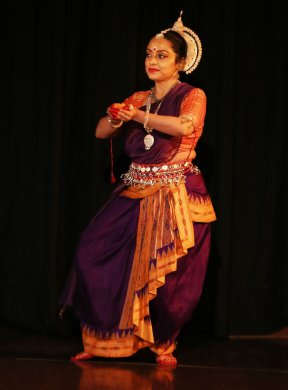 Sumelika Bhattacharyya 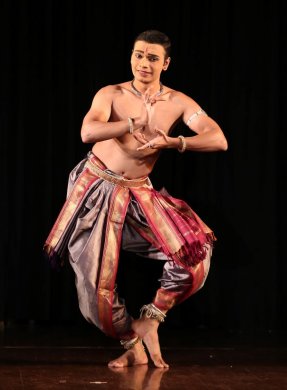 D Dilip By a quirk of fate, the second dancer of the evening, Kuchipudi performer D. Dilip, trained under Guru Sailaja at Saila Sudha Academy, has been mentioned in fair detail in a very recent write-up of this critic. Briefly, starting with a Swati Tirunal kriti in Arabhi ragam as homage to Padmanabha described with brief reference to his persona and deeds, Dilip's conceptualization of the ashtapadi "Radha vadana vilokana vikasita vividha vikara vibhangam" was of particular interest. Here Krishna is portrayed in the mood of sambhoga sringar or love in the promise of fulfillment, with Radha after the torment of separation and misunderstandings, slowly stepping into the forest thicket wherein Krishna eagerly awaits her arrival. The dancer's switch over to Radha's femininity with the light footed jumps to the words vipula pulaka bhara danaturitam rati keli kalabhiradheeram describing how Radha arrives, reveling in this intimate space with the tangles of new shoots growing on creeping vines, full of deep longing for Krishna, showed the ease with which this Kuchipudi performer accommodates gender differences. And of special value was vocalist Srikanth Gopalakrishnan's score and vocal support. The signature line mentioning Jayadeva's poetic genius had a reverential quality in the thanksgiving, both in the singing and the dance. Following the Shiva Panchakshara Stotram, the portrayal of Shiva's dance 'Adenamma' in ragam Attana, based on Pallavi Doraiswamy Aiyer's musical composition choreographed by Dilip's guru Sailaja, less mind-blowingly spectacular than the way it has been danced by the Reddys, ended with footwork intricacies and dancing on a brass plate, tarangam. To end on a note portraying three generations of Kuchipudi with a choreography of Guru Vempati Chinna Satyam under whom Dilip's guru Shailaja trained was the Muthuswami Dikshitar kriti, Kanchadalaayadakshi Kamakshi in ragam Kamalamanohari. For this critic, what signified was the very mixed audience of about seventy persons at the IIC auditorium watching a male presenting Kuchipudi, with deep appreciation. DOUBLE BILL IN INTERACTION AND SOLO GLORY IN DVIPARNA Photos: Innee Singh Interestingly, two styles sharing the stage each evening, in a male/female, tandav/lasya, Yin/Yang contrast was also followed in this year's celebration of Lalitarpan, the festival started by Kathak veteran Shovana Narayan of Asavari, along with Dr.Jyotsna Suri and tabla wizard Shafaat Ahmed Khan. Registering its 22nd year of presentation, with the Executive Committee of Shovana's Kathak school Asavari catering to the work involved in conducting the event, the festival carries the name of Shovana's mother whose encouragement was the starting point of the artiste's long road and career in Kathak. For the first time since the inception of the festival, Shovana, now in Austria nursing her ailing husband, was physically absent, with the three day event at the Habitat totally managed by the Asavari Executive Committee. Selected with much thought, all four participating dancers representing four classical styles, did the festival proud. Kathak dancer Pallavi Lohani, who first studied under Arjun Misra and is now a student of Shovana, combined with creditable understanding with Bharatanatyam performer Suhail Bhan, a student of Bharatiya Kala Kendra trained under Justin McCarthy. The starting "Jai Jai Shankar Jai Tripurari, Jai Ardha Purusha..." with Pallavi becoming Parvati to Suhail's Shiva, and with ardhanaripurush freezes one behind the other and placed side by side, saw the two dancers moving with grace and precision. With his phenomenal agility, Suhail with his quicksilver circling or surru(s) was in every way an equal partner for the speedy bhramaris of the Kathak dancer. Pallavi's neat and graceful teental solo had time- honoured compositions built round intra-forms comprising chalis, compositions built round bols digi digi thai... and dhatakathungaa, traditional composition of Rasdhari of Brindavan in Raas Lila tradition, compositions with chakkars clockwise and anti clockwise, chakradhar, Ginti Tihais and even sringar ched/chad built into a composition of bols in what appears to be pure nritta. The accompanists had well trained singer Madho Prasad, with percussion support on tabla by Shakeel Ahmed. The person providing parhant support could have been more active - considering that she often sat without uttering the bols. 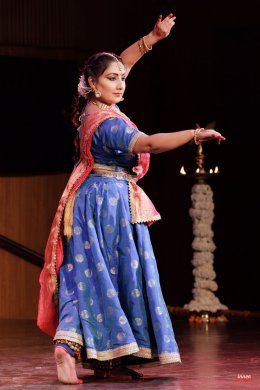 Pallavi Lohani 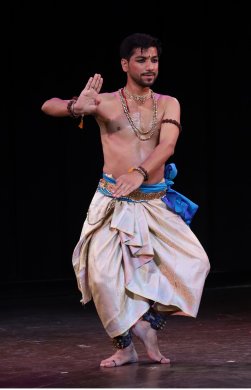 Suhail Bhan Suhail's very traditional solo, with homage to Ganapati in a sloka, went on to presenting the Natesha Kavutvam, this part of the recorded music being sung by Preeti Mahesh. He followed this up with his own mimetic effort based on a Swati Tirunal Ppadam "Panimathi Mukhi Bale" in Aahari ragam, with vocal rendition by Soorya Gayathri. The forlorn Nayika confides in her sakhi, pining that Lord Padmanabha she is waiting for, has not arrived. While, it is time for love for lokavasikal (people in this world) with the moon shining above, for her it brings only the ache of unrequited love. What was pleasantly surprising was to find, not just the inward looking ability for abhinaya, but more so, the mature ease in doing a nayika's role, making the dancer's male presence of little concern. The Todayamangalam, which is part of the Bhajana Sampradayam, and rendered at the start of a music performance, which is quite familiar to Bharatanatyam performers, "Jaya Janaki Ramana" sung by Sudha Raghuraman, was composed for the dance by Suhail's Guru Justin McCarthy. Set in a ragamalika format, it is a talamalika with each statement in a melodic mode set to a different time cycle - the composition with the start in raga Nattai set to khandachapu talam moving on to Aarabhi set to misrachapu following which the statement in Athana is in adi talam followed by Mayamalavagowlam in roopakam. The concluding statement in Pantuvarali is in adi talam. Dedicated to lotus faced Lord Vishnu, the worshipper offers salutations to the husband of Janaki, the husband of Lakshmi, who as Venkataramana resides on the hills, and who as protector destroyed demons like Keshi, the ten headed Ravana, and assuming a half man and half lion form, killed Hiranyakashipu. The composition, bringing out in quick flashes, references to the Lord in opposing roles of savior and protector as well as destroyer of evil, was rendered with impeccable technique and a sense of involvement.  Suhail Bhan & Pallavi Lohani Conceived in collaboration by the two dancers, was the conclusion built round the idea of a maker of statues, confronted with the forms created suddenly coming alive and starting to move (much like the Konark story), till the movement climaxes in the expression of a Tillana/Tarana duet, which was well conceived and made a memorable end to the program. The choice of Swati Tirunal's much rendered Tillana in Dhanashri injected that sense of joyous aplomb, making for the right note to end on. The Mohiniattam/Odissi combine the next evening was equally proficient. Bharati Shivaji's disciple Megha Nair, who also studied at Nalanda Dance Centre in Mumbai, and Vishwanath Mangaraj who for twenty two years has been learning from Odissi teacher Sharon Lowen ushered in the concert together, with an invocation in praise of Lord Krishna, "Kohi kahat tum Krishna Kanhaiya" went the words. Megha's movements emulating the circular grace and swaying torso of Mohiniattam, and the tribhanga/chauka elegance of Odissi in Vishwanath's movements, were well matched. Wisely, instead of seeking complete movement simultaneity, the pair dancing alternately to the same rhythmic syllables "Rita dhrimikita dhrimikita tom" created another way of expressing togetherness. The lasya / tandav interaction came into play in short gestures like Vishwanath as Krishna offering a flower to decorate Radha's hair. Megha's solo, full of swinging grace, comprised the nritta item Mukhachalam set to raga Surutti choreographed by her guru Bharati Shivaji. The abhinaya item was an ashtapadi "Chandanacharchita neela kalebara peeta vasana vanamaali." Sung melodiously in the Sopanam style, it portrayed Radha describing to her sakhis the seductive picture of how Krishna clad in yellow silk, and wildflower garlands was reveling in the midst of several (anekanaari) girls. There was a feel of sensuous joy evoked, as the Mohiniattam dancer pictured the scene, dancing to solfa syllables like gumtagumtari tagumtagumtari, which even in the utterance had a special lilt. 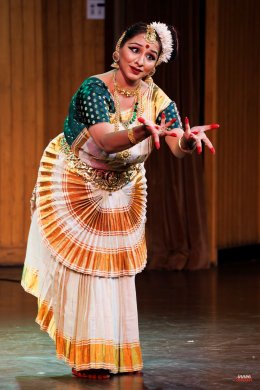 Megha Nair 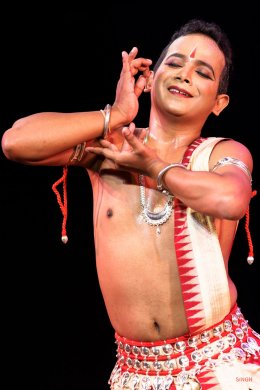 Vishwanath Mangaraj Vishwanath Mangaraj in his Odissi solo presented the Pallavi in Kirwani in khemta of six matras, composed by Bhubaneswar Mishra with dance arrangement by Guru Kelucharan Mohapatra, Sharon Lowen's Guru. Vishwanath as a dancer has developed poise and the upper torso sideways movement, ever so slight and yet very graceful (a hallmark of Kelucharan's style), has been well grasped by him. Being tutored on percussion by father Prafulla Mangaraj, the Mardal expert, Vishwanath has a perfect feel for tala and rhythm. His choice of ashtapadi for abhinaya, was interesting, in that it portrayed Radha, filled with desire for Krishna, pleading with her sakhi to fetch 'the killer of Keshi' to her side - Keshi mathanam udaram' , Bhubaneswar Mishra's delightfully moving music being in Pahadi raag. It is very satisfying to see how male dancers are now untroubled by gender consciousness, and treat the body as just an instrument of dance. The dancer's expression with a delicate smile, showing Radha interacting with the sakhi, reminiscing on the details of the first intimacy with Krishna, subtle and underplayed, was convincing. What did not quite match this was the brash nritta to the line "charana ranitamaninoopuraya paripoorithasuratha vithanam" portraying Radha's recollection of the rhythm of her ankle bells in love play. Surely any recall of such deeply private moments, even if shared with a friend, would be delicately hinted at. Perhaps, with his guru's help, Vishwanath, who has been appreciably maturing under Sharon's guidance, could be persuaded to soften how this line in the ashtapadi is expressed. 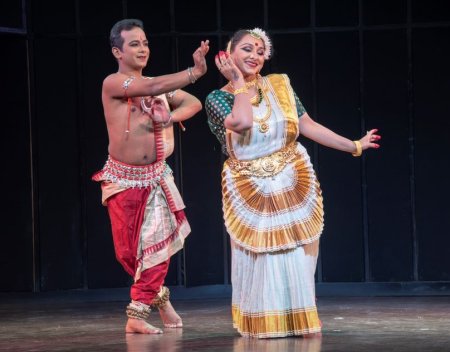 Vishwanath Mangaraj & Megha Nair Moksha made an ideal finale for both dance forms - for Mohiniattam through its item 'Jeeva' strives for the same state of liberated consciousness. The two performers, dancing to the rhythmic syllables in their respective dance forms, closed with a final prayer to the Devi "Sarva mangala maangalye" the closing freeze having Devi as a powerful evil destroyer, with a contrastingly benign and serene Shiva as Nataraj by her side. CELEBRATING THE SPIRIT OF THE MAHATMA THROUGH AN ENSEMBLE OF ART Photos: Rahul Naag For Bhagyam Arts and Ideas, Gandhi Jayanti heralded once again an opportunity for the celebration of the Mahatma's spirit through an ensemble of Indian arts. This exploration of the life and legacy of Gandhi through India's art forms, comprises a core group, that had organized the Gandhi Leela effort last year too, headed by director Suranya Aiyar, whose concept, script, artwork and choreography provide the base for the effort with Ustad Arif Ali Khan's music arrangement and with Rajesh Kumar and Suranya Aiyar as Sutradhars for the dramatized exchanges showing Gandhiji interacting with others. Also part of the ensemble are dancers comprising Swarnali Kundu with her Bharatanatyam contribution alongside Akash Mallick's Kathakali. Other art representatives form a significant part of the effort - like the participants for the Mela, comprising the Katputhli troupe led by Santosh Bhatt, as also pantomime actors of Jagran. This coming together of artistes from various disciplines has enabled retaining the core production, with changes in emphasis introduced in the interactive sessions concerning ideas close to Gandhiji, apart from bringing in fresh dance scenes built round new ideas. Some scenes become inevitable parts of a work built round the Gandhi story, like his favourite prayer song "Vaishnava Janato" becoming the dirge of a weeping nation, after the fatal gunshot sounds, followed by the unforgettable broadcast of the then Prime Minster, "The light has gone out of our lives", with a scene of Swarnali's Bharatanatyam and Kathakali by Akash Mallick giving expression to the poignancy. Also retained is the scene on Punya Smaran with artist Estiyak Ali's on-the-spot sketching of a diagram of Gandhi accompanied by a simultaneous recitation by Rajesh Kumar and Suranya Aiyar, built round Mahadevi Verma's inimitable description of Gandhiji's physical and mental dimensions. This time it is Suranya's own translation of Mahadevi's words, summing up how an unexceptional, plain exterior, hid limitless mental capacities, which guided and changed the course of history. Without reference to Satyagraha, any work on Gandhi has little meaning, though in this year's version, the reference came with a changed accent. It was Gandhiji's implicit faith that one must be the change one wants to see in the world. So Gandhiji made himself the first laboratory wherein his own concepts were tried out. Not yielding to temptation of any type, the self-restraint he imposed on himself to live up to the promises he made to his mother, coupled with not retaliating to the brute forces that violently attacked him in his early years in South Africa, led to the realization gradually, that in a non-violent manner, one could gently shake the world - which would first ignore you, then laugh at you, then fight you and finally finding no retaliation, would soon be the loser. And thus was his idea of non-violent resistance or Satyagraha born. It is this very aspect of Gandhi that was brought out in the dramatized scene 'Mr. Gandhi, what is this Satyagraha movement?' with Rajesh Kumar as Gandhi and Suranya Aiyar as judge representing the Hunter Disorders Committee inquiry (Hindi translation by Bharat Tiwari). When asked if every man could match his almost unnatural ability to resist the most brutal force in a nonviolent fashion, Gandhiji with a gentle smile replied that he in no way considered himself as anything but an ordinary man! 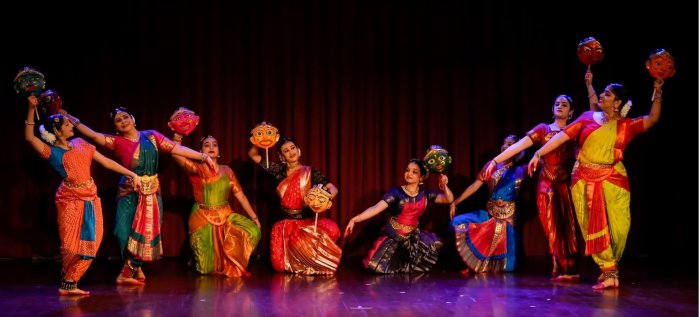 The Navarasa prelude was a fresh inclusion woven round the nine primary moods or states-of-being which form the aesthetic basis for all Indian art. It took the form of a Bharatanatyam scene performed by Shreyasi Gopinath and her students. With the dancers turned out in all the razzle dazzle of colourful costuming, teamed with eye catching jewellery, carrying masks representing Shringara, Hasya, Karuna, Veera, Adbhuta, Raudra, Bhayanaka, Bhibhatsa and Shanta in the hands, the focus on the facial expression, which formed the base of this scene, got blurred. More deliberate movement, with a one-colour costume (or perhaps each mood represented in one colour) with jewellery and accoutrements kept to the minimum, would put the accent on mukhabhinaya, communicating the mood changes more effectively. The dancers were animated but with too many frills, the scene looked crowded without clarity. 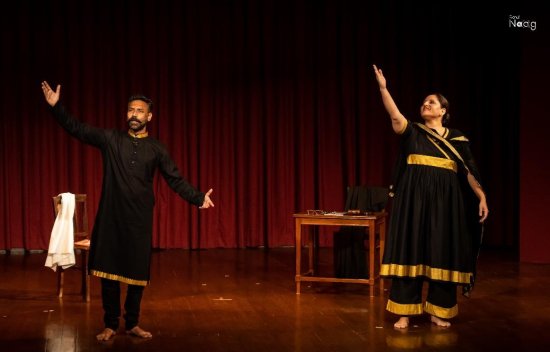 Rajesh Kumar and Suranya Aiyar A dramatized debate with Rajesh Kumar and Suranya Aiyar, directed by Suranya Aiyar, was based on her writings, inspired by the actual utterances of great leaders like Gandhiji, Martin Luther King, Robert Oppenheimer and others, with Mahmood Farooqui helping with Urdu and Hindi translation . It was about Beloved Community, a phrase coined by Martin Luther King referring to the ideal society knit by love and fellow feelings, (akin to the Indian Vasudeiva Kutumbakam philosophy). Participants for this came from many art disciplines, like Jagran's Manish Raj Mehra as Kuroko, pantomime artistes Nur Kumar, Mohammad Raiz and Krishna Kant, the Navarasa dancers and Swarnali Kundu in Bharatanatyam and Birju Bhatt's Katputhli were all involved. Stealing the show were the tiny tots in the Bharatanatyam scene. Full marks to them! Puppets, the Charkha, three monkeys showing hear no evil, speak no evil and do no evil were all expressed here. Ahimsa for Gandhi was the basis of dealing with fellow human beings. 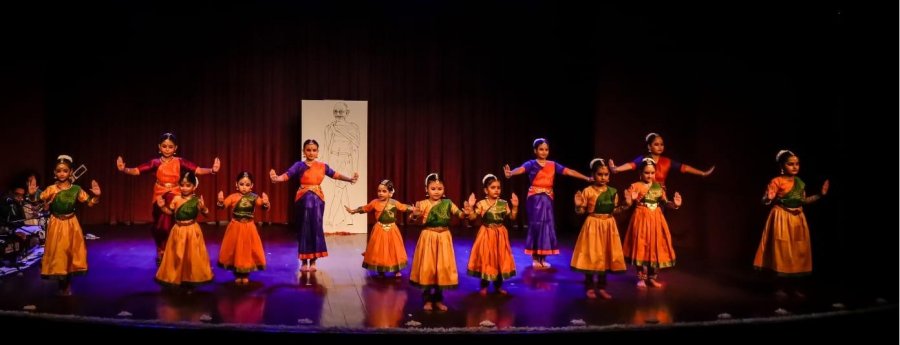 Swarnali Kundu's young students in Bharatanatyam What happens to all these concepts of never hurting a fellow human, when the world is faced with the terrible reality of wars? When the enemies have no concern for anything like a just war, and the truth of concentration camps showed what man was doing to man, where did the idea of Satyagraha fit in? And Gandhiji insisted that all attempts at Swaraj had to cease during the war and that it was India's duty to support the British who along with their supporters, were involved in fighting injustice of the likes of Hitler and Mussolini. The Mahabharata also speaks of Dharma Yuddha, and warrior Arjuna refusing to fight the Kurukshetra war against close relatives he has grown up with, is advised by Krishna to cast aside his unmanliness and faint heartedness. Ahimsa Sangagharsh, the concluding section of Gandhi Leela posed this question of whether one can survive without committing violence of one kind or another. Is there such a thing as a just war? Can inflicting so much pain mentally and physically on so many people be right action? The famous Krishna/Arjuna dialogue when Krishna explains to Arjuna the importance of paying heed to one's actions and duty without bothering about the fruits of action, portrayed through a Kathakali/Kathak interaction staged by Akash Mallick and Mayukh Bhattacharya, was a fine idea. But starting with the famous words of Krishna, karmanyevaadhikaarastu ma phaleshu kadachana, on not acting for the fruits of action, to the entire philosophy of Karma and Dharma, and belief that when Adharma proliferates to the extent of exterminating Dharma, divinity will appear in our midst in some form to re-establish the power of justice, the text gives little scope for movement in dance - for all the emphasis is on internalized expression. This makes the danced expression particularly challenging. With repeated presentations and growing involvement, the choreography as it is, should acquire a stronger tone of conviction. While whole heartedly applauding the strenuous effort involved in putting together a many sided show of this nature, my word of advice to the vocalists in the live music parts, would be to strive for more sur control. With so many art expressions, this would be a good way of painlessly educating our young people in institutions on Gandhi's thoughts.  Writing on the dance scene for the last forty years, Leela Venkataraman's incisive comments on performances of all dance forms, participation in dance discussions both in India and abroad, and as a regular contributor to Hindu Friday Review, journals like Sruti and Nartanam, makes her voice respected for its balanced critiquing. She is the author of several books like Indian Classical dance: Tradition in Transition, Classical Dance in India and Indian Classical dance: The Renaissance and Beyond. Post your comments Pl provide your name and email id along with your comment. All appropriate comments posted with name and email id in the blog will also be featured in the site. |